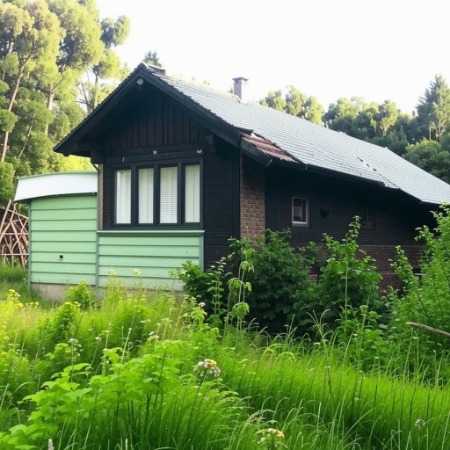The internal corner of a house roof is one of the most important structural zones that requires special attention during the design and installation of the roofing system. It is precisely at the junctions of the roof slopes that internal corners form, which are potentially vulnerable to moisture penetration and leaks. Proper construction of the internal corner ensures reliable protection of the building from atmospheric influences and contributes to the durability of the roof.
In this article, we will examine in detail what an internal corner in the roof is, what problems may arise in this area, how to properly arrange it, what materials and technologies are used, and provide recommendations for maintenance and prevention.
What is an Internal Corner in the Roof and Why Is It Important
An internal corner of the roof is the area where two roof slopes meet at an acute angle, forming a valley or gutter. Unlike the external corner, which protrudes beyond the building, the internal corner is directed inward and serves as a place for rainwater runoff. This zone concentrates water flow, increasing the risk of leaks if waterproofing is insufficient.
The internal corner functions to collect and direct water into the drainage system. If it is improperly constructed, water can stagnate and penetrate under the roofing material, causing damage to insulation and supporting structures. Additionally, internal corners tend to accumulate debris, leaves, and snow, exacerbating the problem.
The quality of the internal corner affects not only waterproofing but also the aesthetics of the roof. Unevenness, cracks, and deformations in this area can lead to premature material wear and deterioration of the building’s appearance.
Main Problems and Causes of Damage in the Internal Corner
The internal corner of the roof is subjected to significant loads from both water and temperature deformations. The main problems arising in this zone are leaks, waterproofing damage, and mechanical failures.
A common cause of damage is the improper selection or installation of roofing materials. If the waterproofing does not overlap the internal corner with enough margin, water penetrates joints and seams. Poor treatment of junctions and lack of reinforcement worsen the situation.
Temperature fluctuations cause expansion and contraction of materials, leading to cracks. Internal corners are especially vulnerable when rigid roofing materials are used without compensating elements. Additionally, water stagnation and debris accumulation promote mold growth and wood rot.
Improper or clogged drainage systems increase water levels in the corner, intensifying hydrostatic pressure and accelerating material wear.
Technologies and Materials for Constructing the Internal Corner
Modern construction offers several technologies for reliably constructing the internal corner of the roof, ensuring durability and waterproofing. The basis lies in the correct choice of materials and the sequence of installation operations.
One traditional solution is the installation of a metal valley or flashing, which serves as a guide for water runoff. The metal can be galvanized, copper, or aluminum, providing corrosion resistance. The valley is installed with a slope ensuring free water drainage.
A crucial element is the waterproofing layer, which is laid with an overlap onto adjacent slopes. Typically, roll materials based on bitumen or polymers, as well as liquid waterproofing mastics, are used. To increase strength and elasticity, reinforcing meshes or tapes are employed.
In some cases, specially profiled elements made of PVC or EPDM are used, simplifying installation and ensuring tightness. The welding and gluing technology of seams plays a key role in preventing leaks.
Step-by-Step Guide to Installing the Internal Corner of the Roof
Installation of the internal corner begins with thorough preparation of the base. The surface is cleaned of dust, dirt, and old materials, leveled and dried if necessary. This ensures reliable adhesion of the waterproofing to the base.
Next, the main waterproofing layer is laid with sufficient overlap onto the adjacent slopes. Special attention is paid to the quality and tightness of laying in the corner zone, where the material must be additionally reinforced with reinforcing elements.
After that, the metal valley or flashing is installed and fastened to the base with the required slope. Joints and junctions are carefully sealed with mastics or special tapes. When using roll materials, seams are welded hot or glued.
The final stage is checking the tightness and integrity of the structure. Protective elements preventing debris ingress and providing an aesthetic appearance are installed if necessary.
Maintenance and Prevention of the Internal Corner of the Roof
To maintain the functionality of the internal corner of the roof, regular inspections and preventive measures are necessary. Special attention is paid to the condition of waterproofing, metal elements, and drainage systems.
Periodic cleaning of the corner from leaves, branches, and other debris prevents water stagnation and corrosion development. If damage to the waterproofing layer or metal is detected, prompt repair with replacement or restoration of materials is required.
It is important to monitor the condition of gutters and drainage channels to exclude clogs and overflow. Fastening elements and sealants should also be checked and renewed as they wear out.
Timely maintenance and prevention significantly extend the service life of the internal corner and the entire roofing system as a whole.
Table Comparing Popular Materials for Constructing the Internal Corner
| Material | Strength | Waterproofing | Corrosion Resistance | Installation Complexity | Service Life | Cost |
|---|---|---|---|---|---|---|
| Galvanized Steel | High | High | Medium | Medium | 15-20 years | Low |
| Copper | Very High | Very High | Very High | High | 40-50 years | High |
| Aluminum | High | High | High | Medium | 20-25 years | Medium |
| Bitumen Roll Materials | Medium | High | Low | Medium | 7-10 years | Low |
| Polymer Membranes | High | Very High | Very High | Medium | 20-30 years | Medium |

